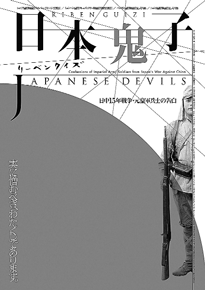Crimes prior to, during WWII given stark treatment in Japanese documentary
In the U.S., Japan isn’t thought of as a nation given to political unrest or rebellion. But some of its films tell a different story.
Nagisa Oshima’s early work documents a generation of leftists fighting against the American military presence. The country has produced some of the most powerful anti-war films ever made, including Kon Ichikawa’s “Fires on the Plain” and Kinji Fukasaku’s “Under the Flag of the Rising Sun,” which played earlier in the Japan Society’s current “After War…” series. In the late 60s, Koji Wakamatsu combined radical politics and soft-core porn, making work that suggests Jean-Luc Godard’s “Le Chinoise” or “Weekend” if the characters had sex every 15 minutes.
Recent Japanese films often use genre tropes to allegorize present-day social malaise. However, Minoru Matsui’s 2001 documentary “Japanese Devils” directly treats a taboo subject––Japanese war crimes preceding and during World War II. Matsui’s film tells a story that’s been buried in Japan. He began making it with no financial support except his own money—no TV station or production company would invest in it.
The military, during the occupation of Manchuria and China in the 1930s and early ‘40s, committed thousands of atrocities. These were fairly well known in the rest of Asia and in the West, but the Japanese government successfully hid them from its own people. The country no longer has an official military and purports to follow a path of peace, but its school’s history books still neglect these rapes and murders.
“Japanese Devils” begins at a protest at the Yasukuni Shrine on the anniversary of Japan’s surrender in World War II. Two groups are yelling at each other—one wants to praise the dead soldiers as heroes and martyrs, while the other objects to glorifying them. Quickly, Matsui offers a voice-over giving his opinion on Japan’s willful ignorance of its war crimes. His film is based around interviews with 14 elderly veterans, but it also offers a quick summation of Japan’s invasion of China. Matsui structures the film chronologically, alternating testimony from the former soldiers with very brief descriptions of the historical background.
Hong Kong director Tun Fei Mou’s 1988 film “Men Behind the Sun” centers on Japanese war crimes against the Chinese, but it’s notoriously difficult watching––especially for its scenes of genuine cruelty to animals—and generally considered an Asian equivalent to the trashy likes of “Ilsa, She-Wolf of the S.S.”
Matsui takes an approach closer to “Shoah” director Claude Lanzmann’s and, more recently, Cambodian-French director Rithy Panh’s “S21: The Khmer Rouge Killing Machine.” There are no re-stagings of events, just a few brief interpolations of period newsreel footage. “Japanese Devils” is a talkfest, but the conversations are as disturbing as any images could be.
Matsui’s subjects are disarmingly polite and matter-of-fact. No one breaks down in a sudden burst of emotion or gets overly defensive. Their interviews are filmed in a blunt, almost artless style—medium shots and close-ups of faces, usually edited from several different camera angles. Matsui relies on words alone to carry the viewer’s interest.
From the very first interview, “Japanese Devils” is a harrowing experience. Yoshio Tsuchiya describes the Japanese tactic of “strict disposal,” which meant killing Chinese civilians on sight. The soldiers were given rewards for killing the most people. His description of torture methods almost comes as light relief.
The veterans’ confessions get more and more brutal. A doctor recalls the hideous medical training sessions in which Chinese men were shot so that students could try and remove the bullets before they died. Few succeeded. Another man tells of raping a woman, killing her, and then serving her body as meat to his battalion. Matsui’s subjects make it clear that these weren’t isolated incidents, although he wasn’t able to interview any of their superiors.
Judging “Japanese Devils” as a work of art is difficult. It’s not very imaginatively directed. Its information could probably be conveyed just as well in the form of a book, since what its subjects say matters far more than how they say it. In his 1997 film “A Visitor From the Living,” Lanzmann managed to make a 65-minute interview riveting, but Matsui doesn’t share his skill.
On the other hand, these reminiscences might be more powerful because they’re treated so starkly. Matsui doesn’t pass judgment on his subjects, allowing them to talk without interruption. Except at the film’s beginning and end, his voice remains silent, yet his perspective is implicit in the editing.
Even as Matsui scathingly criticizes Japan for ignoring its war crimes, he shows a few signs of optimism––images of a peace museum where veterans lay bare their guilty consciences at crowded Q & A sessions. “Japanese Devils” doesn’t compare to the best documentaries about the Holocaust––“Shoah” and Alain Resnais’ short “Night and Fog”––but it’s a passionate cry to remember the past and take responsibility for it.
gaycitynews.com



































